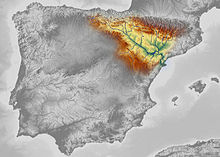Neanderthal extinction
[6] However, it is postulated that Iberian Neanderthals persisted until about 35,000 years ago, as indicated by the date range of transitional lithic assemblages—Châtelperronian, Uluzzian, Protoaurignacian and Early Aurignacian.
[4] A claim of Neanderthals surviving in a polar refuge in the Ural Mountains[15] is loosely supported by Mousterian stone tools dating to 34,000 years ago from the northern Siberian Byzovaya site at a time when modern humans may not yet have colonised the northern reaches of Europe;[16] however, modern human remains are known from the nearby Mamontovaya Kurya site dating to 40,000 years ago.
[25] Kwang Hyun Ko discusses the possibility that Neanderthal extinction was either precipitated or hastened by violent conflict with Homo sapiens.
The catastrophic impact of Eurasian viruses on Native American populations in the historical past offers a sense of how modern humans may have affected hominin predecessor groups in Eurasia 40,000 years ago.
Mathematical models have been used to make forecasts for future investigations, giving information about inter-species interactions during the shift between the Middle and Upper Paleolithic eras.
[30] In late-20th-century New Guinea, due to cannibalistic funerary practices, the Fore people were decimated by transmissible spongiform encephalopathies, specifically kuru, a highly virulent disease spread by ingestion of prions found in brain tissue.
[33][34] Generally small and widely dispersed fossil sites suggest that Neanderthals lived in less numerous and socially more isolated groups than contemporary Homo sapiens.
Tools such as Mousterian flint stone flakes and Levallois points are remarkably sophisticated from the outset, yet they have a slow rate of variability and general technological inertia is noticeable during the entire fossil period.
Artifacts are of utilitarian nature, and symbolic behavioral traits are undocumented before the arrival of modern humans in Europe around 40,000 to 35,000 years ago.
These include the Neanderthals' smaller parietal lobes[37][38][39] and cerebellum,[40][41] areas implicated in tool use,[42] visuospatial integration,[43] numeracy,[44] creativity,[45] and higher-order conceptualization.
Both male and female Neanderthals participated in the single occupation of hunting big game, such as bison, deer, gazelles, and wild horses.
This hypothesis proposes that the Neanderthal's relative lack of labour division resulted in less efficient extraction of resources from the environment as compared to Homo sapiens.
[48] Researchers such as Karen L. Steudel of the University of Wisconsin have highlighted the relationship of Neanderthal anatomy (shorter and stockier than that of modern humans) and the ability to run and the requirement of energy (30% more).
[49] Nevertheless, in the recent study, researchers Martin Hora and Vladimir Sladek of Charles University in Prague show that Neanderthal lower limb configuration, particularly the combination of robust knees, long heels, and short lower limbs, increased the effective mechanical advantage of the Neanderthal knee and ankle extensors, thus reducing the force needed and the energy spent for locomotion significantly.
[61] Due to the lack of genetic diversity, Neanderthal populations would have become more vulnerable to climatic changes, diseases, and other stressors, which may have contributed to their extinction.
Interbreeding and assimilation, which were hypothesized as causes in the death of European Neanderthal populations, are successful only for low levels of food competition.


